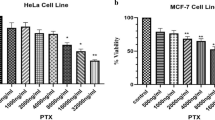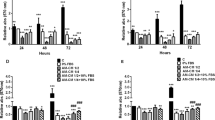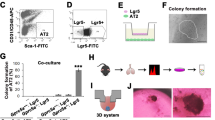Abstract
The differentially expressed in adenocarcinoma of the lung-1 (DAL-1) protein has been demonstrated to be suppressive to various types of tumors including lung cancer. This study aimed to determine the targeted effects of human amniotic fluid stem cells (hAFS cells) carrying CXCR4 promoter driven conditionally replicable adenovirus vector overexpressing DAL-1 (Ad-CXCR4-DAL-1) on non-small cell lung carcinoma (NSCLC) growth. The apoptotic effects of virus vectors were assessed using flow cytometry, and the cytotoxicity analyzed by CCK-8 assay. In vivo imaging system was used to determine the homing capability of hAFS cells. A549 cell xenograft mouse model was created to assess the in vivo effect of DAL-1 overexpression on NSCLC growth. We found that infection of Ad-CXCR4-DAL-1 increased the apoptosis of A549 NSCLC cells but not 16HBE normal human bronchial epithelial cells. Ad-CXCR4-DAL-1 administered via intratumoral injection led to significant reduced growth and greater necrosis of A549 xenograft tumors comparing to null vector treated animals. When infused via tail vein, hAFS cells carrying Ad-CXCR4-DAL-1 homed to lung cancer xenografts, caused virus replication and DAL-1 overexpression, and led to significant lower growth and greater necrosis of A549 cell xenografts comparing to non-treatment control. In conclusion, hAFS cells are capable of carrying Ad-CXCR4-DAL-1 vectors, specifically targeting to lung cancer, and causing oncolytic effects when administered in vivo.
This is a preview of subscription content, access via your institution
Access options
Subscribe to this journal
Receive 12 print issues and online access
$259.00 per year
only $21.58 per issue
Buy this article
- Purchase on Springer Link
- Instant access to full article PDF
Prices may be subject to local taxes which are calculated during checkout






Similar content being viewed by others
References
Dresler C . The changing epidemic of lung cancer and occupational and environmental risk factors. Thorac Surg Clin 2013; 23: 113–122.
Siegel R, Naishadham D, Jemal A . Cancer statistics, 2013. CA Cancer J Clin 2013; 63: 11–30.
Zhang Y, Xu R, Li G, Xie X, Long J, Wang H . Loss of expression of the differentially expressed in adenocarcinoma of the lung (DAL-1) protein is associated with metastasis of non-small cell lung carcinoma cells. Tumour Biol 2012; 33: 1915–1925.
Komarova S, Kawakami Y, Stoff-Khalili MA, Curiel DT, Pereboeva L . Mesenchymal progenitor cells as cellular vehicles for delivery of oncolytic adenoviruses. Mol Cancer Ther 2006; 5: 755–766.
Chiocca EA . Oncolytic viruses. Nat Rev Cancer 2002; 2: 938–950.
Vile R, Ando D, Kirn D . The oncolytic virotherapy treatment platform for cancer: unique biological and biosafety points to consider. Cancer Gene Ther 2002; 9: 1062–1067.
Armstrong L, Arrington A, Han J, Gavrikova T, Brown E, Yamamoto M et al. Generation of a novel, cyclooxygenase-2-targeted, interferon-expressing, conditionally replicative adenovirus for pancreatic cancer therapy. Am J Surg 2012; 204: 741–750.
Xu HN, Huang WD, Cai Y, Ding M, Gu JF, Wei N et al. HCCS1-armed, quadruple-regulated oncolytic adenovirus specific for liver cancer as a cancer targeting gene-viro-therapy strategy. Mol Cancer 2011; 10: 133.
Nikzaban M, Hakhamaneshi MS, Fakhari S, Sheikhesmaili F, Roshani D, Ahsan B et al. The chemokine receptor CXCR4 is associated with the staging of gastric cancer. Adv Biomed Res 2014; 3: 16.
Han M, Lv S, Zhang Y, Yi R, Huang B, Fu H et al. The prognosis and clinicopathology of CXCR4 in gastric cancer patients: a meta-analysis. Tumour Biol 2014; 35: 4589–4597.
Lee WY, Zhang T, Lau CP, Wang CC, Chan KM, Li G . Immortalized human fetal bone marrow-derived mesenchymal stromal cell expressing suicide gene for anti-tumor therapy in vitro and in vivo. Cytotherapy 2013; 15: 1484–1497.
Hsiao WC, Sung SY, Liao CH, Wu HC, Hsieh CL . Vitamin D3-inducible mesenchymal stem cell-based delivery of conditionally replicating adenoviruses effectively targets renal cell carcinoma and inhibits tumor growth. Mol Pharm 2012; 9: 1396–1408.
Sessarego N, Parodi A, Podesta M, Benvenuto F, Mogni M, Raviolo V et al. Multipotent mesenchymal stromal cells from amniotic fluid: solid perspectives for clinical application. Haematologica 2008; 93: 339–346.
Kim EY, Lee KB, Kim MK . The potential of mesenchymal stem cells derived from amniotic membrane and amniotic fluid for neuronal regenerative therapy. BMB Rep 2014; 47: 135–140.
Bottai D, Scesa G, Cigognini D, Adami R, Nicora E, Abrignani S et al. Third trimester NG2-positive amniotic fluid cells are effective in improving repair in spinal cord injury. Exp Neurol 2014; 254: 121–133.
Heise C, Kirn DH . Replication-selective adenoviruses as oncolytic agents. J Clin Invest 2000; 105: 847–851.
Shien K, Tanaka N, Watanabe M, Soh J, Sakaguchi M, Matsuo K et al. Anti-cancer effects of REIC/Dkk-3-encoding adenoviral vector for the treatment of non-small cell lung cancer. PLoS One 2014; 9: e87900.
Kim KH, Dmitriev IP, Saddekni S, Kashentseva EA, Harris RD, Aurigemma R et al. A phase I clinical trial of Ad5/3-Delta24, a novel serotype-chimeric, infectivity-enhanced, conditionally-replicative adenovirus (CRAd), in patients with recurrent ovarian cancer. Gynecol Oncol 2013; 130: 518–524.
Yageta M, Kuramochi M, Masuda M, Fukami T, Fukuhara H, Maruyama T et al. Direct association of TSLC1 and DAL-1, two distinct tumor suppressor proteins in lung cancer. Cancer Res 2002; 62: 5129–5133.
Terada N, Ohno N, Yamakawa H, Baba T, Fujii Y, Ohara O et al. Immunolocalization of protein 4.1B in the rat digestive system. J Mol Histol 2004; 35: 347–353.
Cavanna T, Pokorna E, Vesely P, Gray C, Zicha D . Evidence for protein 4.1B acting as a metastasis suppressor. J Cell Sci 2007; 120: 606–616.
Wohlfahrt ME, Beard BC, Lieber A, Kiem HP . A capsid-modified, conditionally replicating oncolytic adenovirus vector expressing TRAIL Leads to enhanced cancer cell killing in human glioblastoma models. Cancer Res 2007; 67: 8783–8790.
Pozzobon M, Piccoli M, De Coppi P . Stem cells from fetal membranes and amniotic fluid: markers for cell isolation and therapy. Cell Tissue Bank 2014; 15: 199–211.
Bitsika V, Vlahou A, Roubelakis MG . Fetal mesenchymal stem cells in cancer therapy. Curr Stem Cell Res Ther 2013; 8: 133–143.
Si XY, Li JJ, Yao T, Wu XY . Transforming growth factor-beta1 in the microenvironment of ischemia reperfusion-injured kidney enhances the chemotaxis of mesenchymal stem cells to stromal cell-derived factor-1 through upregulation of surface chemokine (C-X-C motif) receptor 4. Mol Med Rep 2014; 9: 1794–1798.
Sohni A, Verfaillie CM . Mesenchymal stem cells migration homing and tracking. Stem Cells Int 2013; 2013: 130763.
Rajendran S, O'Hanlon D, Morrissey D, O'Donovan T, O'Sullivan GC, Tangney M . Preclinical evaluation of gene delivery methods for the treatment of loco-regional disease in breast cancer. Exp Biol Med (Maywood) 2011; 236: 423–434.
Yang SW, Cody JJ, Rivera AA, Waehler R, Wang M, Kimball KJ et al. Conditionally replicating adenovirus expressing TIMP2 for ovarian cancer therapy. Clin Cancer Res 2011; 17: 538–549.
Shinojima N, Hossain A, Takezaki T, Fueyo J, Gumin J, Gao F et al. TGF-beta mediates homing of bone marrow-derived human mesenchymal stem cells to glioma stem cells. Cancer Res 2013; 73: 2333–2344.
Acknowledgements
This study was funded by the Education Department of China for Doctorate Advisor (20134423110001), Guangdong Natural Science Foundation (S2012010010181), Guangzhou Science and Technology Scheme (2014Y2-00171), and Guangzhou Department of Education for Innovative Academic Team (13C06) grants.
Author information
Authors and Affiliations
Corresponding author
Ethics declarations
Competing interests
The authors declare no conflict of interest.
Rights and permissions
About this article
Cite this article
Li, L., Li, S., Cai, T. et al. The targeted inhibitory effects of human amniotic fluid stem cells carrying CXCR4 promoter and DAL-1 on non-small cell lung carcinoma growth. Gene Ther 23, 214–222 (2016). https://doi.org/10.1038/gt.2015.90
Received:
Revised:
Accepted:
Published:
Issue Date:
DOI: https://doi.org/10.1038/gt.2015.90



